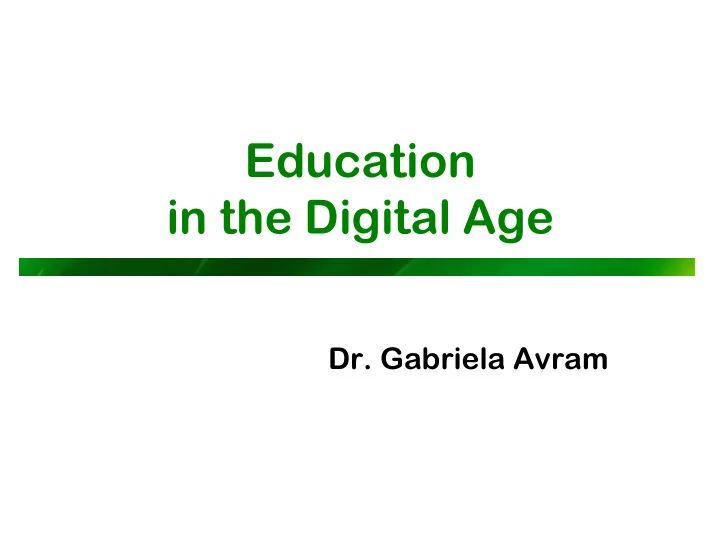

Education in the Digital Age Dr. Gabriela Avram
Definition of learning The act, process, or experience of gaining knowledge or skill, through schooling or study. Process of acquiring modifications in existing knowledge, skills, habits, or tendencies through experience, practice, or exercise. Learning includes associative processes (see association; conditioning), discrimination of sense-data, psychomotor and perceptual learning, imitation, concept formation, problem solving, and insight learning.
Blended learning Blended Learning is the combination of multiple approaches to learning. Blended learning can be accomplished through the use of 'blended' virtual and physical resources. A typical example of this would be a combination of technology-based materials and face-to-face sessions used together to deliver instruction.
Controlled environment You are being taught You are expected to learn You are expected to be able to ask questions, and to be able to answer them But you can, and should: apply what you learned in projects work on topics you choose
What about taking control? Blogs, e-portfolio Object-centred social network platforms: YouTube, Flickr, diigo, CiteULike, Slideshare Social networks for finding peers and mentors (LinkedIn, Facebook, Twitter) and sharing your content
What should change? You should follow your interests and feed them You should have fun You should invite serendipity in
More.. Google Code University CodeAcademy Lynda.com Podcasts (http://www.cbc.ca/radio/spark/pastepisodes, http://medea.mah.se/vox/ ) Wikipedia My favourite… Lynda.com
A few points for discussion:
Format What is wrong with the lecture-based format? The vessel metaphor vs. the ignition metaphor Mark Twain: "College is a place where a professor's lecture notes go straight to the students' lecture notes, without passing through the brains of either."
E-learning You are enrolled in a formal university course. What are the differences between this situation and self-directed learning, where you choose the content, the format and the pace of your learning? How appropriate is the content taught in 3rd level education to the challenges encountered after graduation in the real world?
Using Online Portfolios and Social Media channels for building a professional profile
1.The role of a portfolio Definition: “ a collection of authentic and diverse evidence, drawn from a larger archive representing what a person or organization has learned over time on which the person or organization has reflected, and designed for presentation to one or more audiences for a particular rhetorical purpose ”. National Learning Infrastructure Initiative US (2003).
Learning and professional portfolios As a practitioner (or fresh While learning, a portfolio graduate, or student supports: applying for an Collecting and internship), it displays selecting. evidence for: Sharing. Professional skills Reflecting. Quality and standard of work Collaborating. Experience acquired in Annotating. past projects Presenting. Preferences and interests
2. From portfolios to ePortfolios “An electronic portfolio, also known as an e -portfolio or digital portfolio, is a collection of electronic evidence assembled and managed by a user, usually on the Web. These are demonstrations of the user's abilities and platforms for self-expression, and they can be maintained dynamically over time. Some e-portfolio applications permit varying degrees of audience access, so the same portfolio might be used for multiple purposes. (Wikipedia on ePortfolios)
The advantages of having an online portfolio Accessibility Storage (not only text, but also video, audio, photos and sketches) Easy to create Easy to share Sociability (harnessing the power of Social Media) Gives a boost of professionalism to one’s online identity Allows for more freedom, creativity and breadth then just a cover letter and resumé
Why maintaining a portfolio? As learning diary For marketing and self- promotional reasons- while looking for a job For professional and creative self-expression For networking with peers and establishing a professional identity For performance appraisal and promotion in an existing job
What would Google expose to a potential employer?! Searching for your own digital traces on the web - a must! Do you blog? Do you tweet? Do you have your own domain/website? Are you on Facebook? Have you a LinkedIn profile? Are you on Plaxo, Xing? Academia.edu anyone? Scribd? Slideshare? YouTube? Soundscape? Flickr, Delicious, Diigo, CiteULike? How are they connected? Are they connected at all? Google your own name. What does the Internet know about you?
4.Using Social Media channels effectively Creating an online presence – a website, a blog; buying your own domain name Creating a Linkedin profile Joining professional communities: LinkedIn groups, Academia.edu, ORCID Joining Twitter, Instagram Joining Facebook and becoming a fan of specific Pages and a member of Groups A public profile page on Facebook? Joining Diigo, CiteULike, Mendeley, Zotero Joining YouTube, SoundCloud, AudioBoom, SlideShare About.me
There are new tools on the way Diaspora Loomio Mastodon Go and try some out!
Branding Try to use the same name and profile picture everywhere Don’t join unless you’re planning to use it! Decide what’s your favourite channel and make content flow through it (this might change over time!) You can’t be everywhere, 24/7 Be good at one thing at the time! Network, network, network!
Challenges Information needs to be kept up-to-date Relationships have to be maintained Having a coherent online presence requires spending time – finding the right balance Embarrassing information can be discovered by potential employers Any little mistake in an online artefact can have huge implications!
5. Creating your portfolio online Sites that could host your portfolio, providing both the software and the hosting space for free: o Google Sites (10Mb) (http://sites.google.com/) o Blogger.com (1Mb) o WordPress.com (3Mb) o Weebly.com o Wix.com o SquareSpace (https://www.squarespace.com) If you want to buy your own domain and host it yourself, WordPress can do this. (the software can be downloaded from www.wordpress.org)
Specialised portfolio services Behance.net Dribble.com Clippings.me
Examples: Portfolios of UL students and alumni Sharon Brosnan – Digital Media Design, 2010 Triona Butler – iMedia, 2010 Daniel Beere – Digital Media Design, 2012 Aoife O’Dwyer - Digital Media Design, 2015 Adriana Janicka – Digital Media Design, 2018
Recommend
More recommend